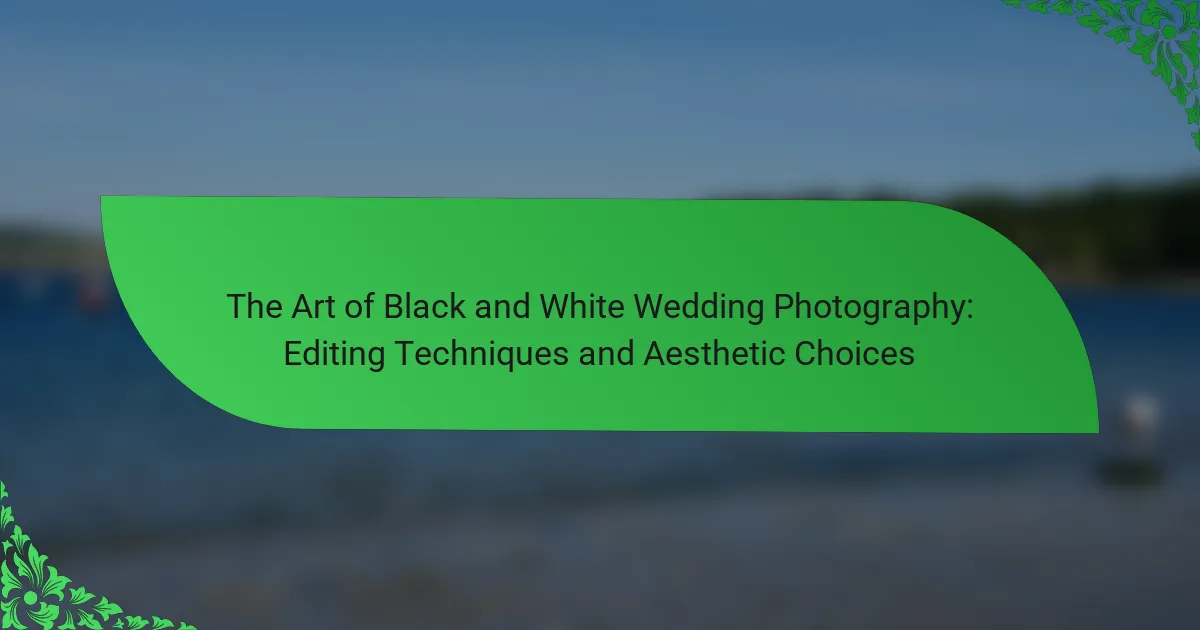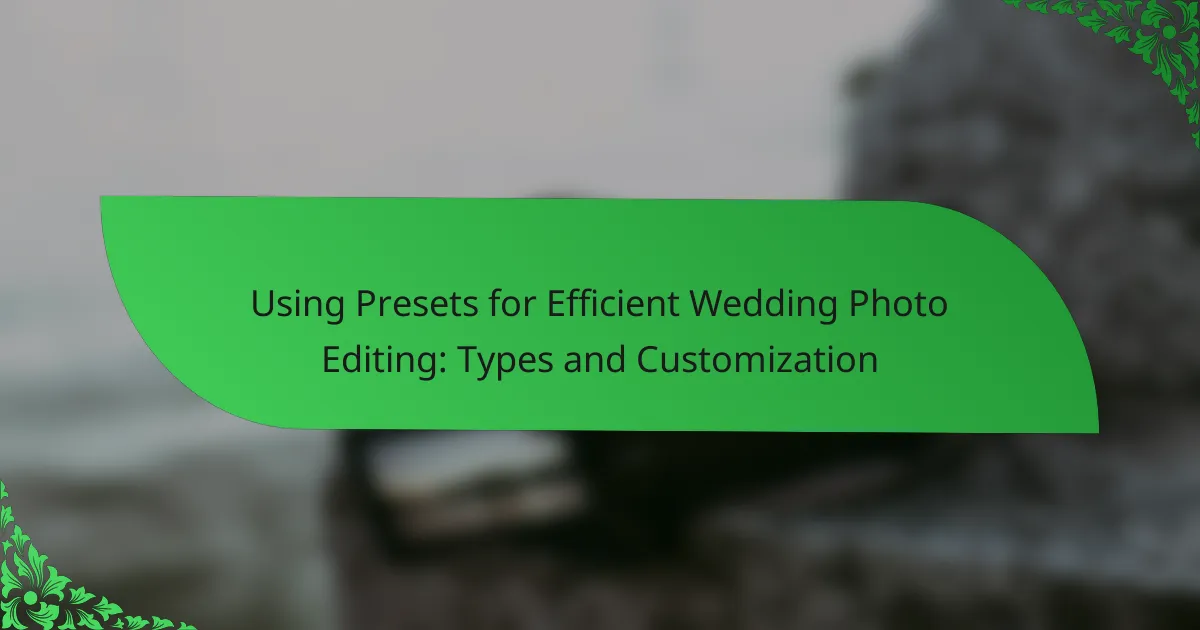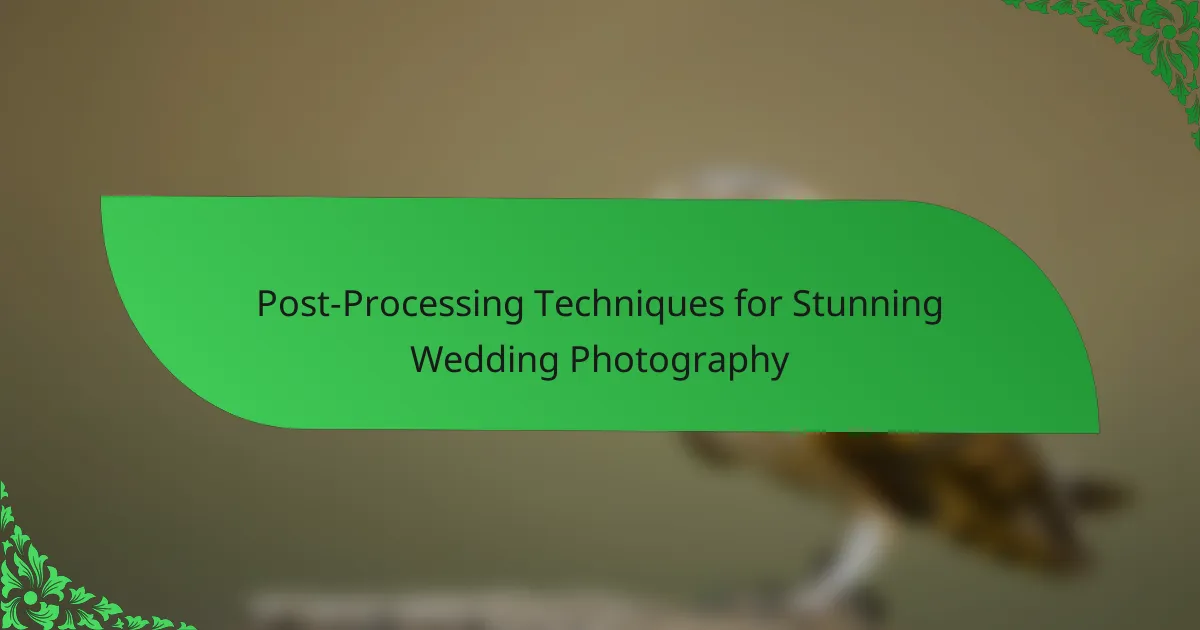Black and white wedding photography is a specialized art form that captures emotions and moments through the use of contrast, texture, and composition, devoid of color. This style enhances the narrative of a wedding day, evoking nostalgia and creating a dramatic atmosphere. Key editing techniques such as contrast adjustment, tonal range manipulation, and sharpening are essential for achieving impactful images. Additionally, aesthetic choices involving contrast, composition, and lighting play a crucial role in shaping the storytelling aspect of the photographs. This article explores the techniques and choices that define the art of black and white wedding photography.
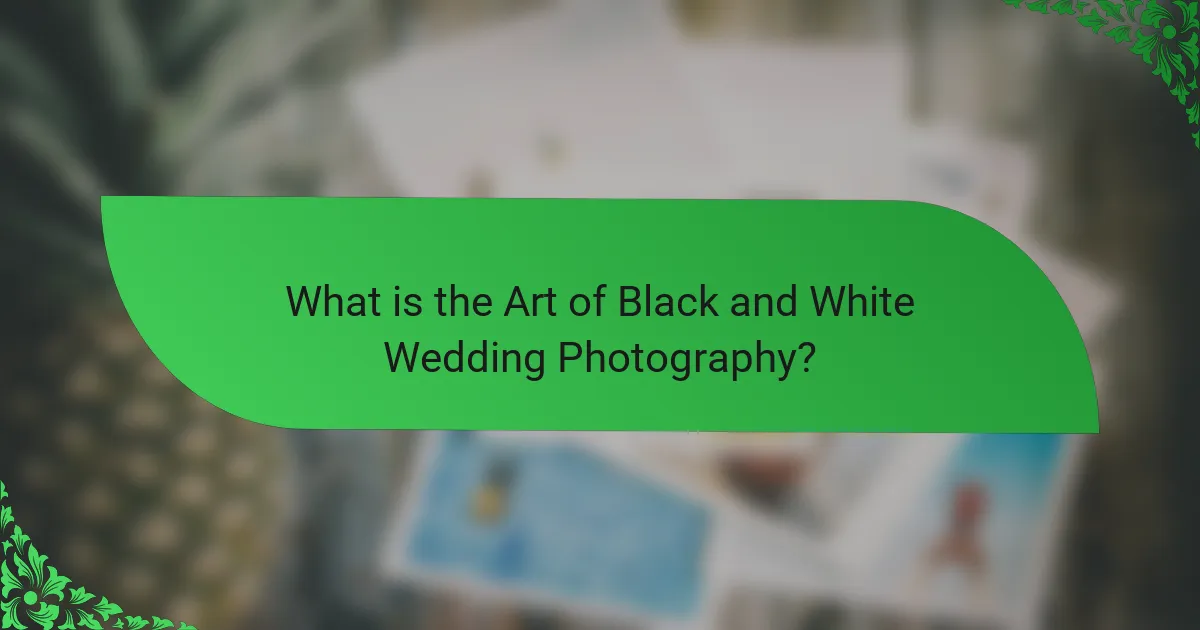
What is the Art of Black and White Wedding Photography?
The art of black and white wedding photography focuses on capturing emotions and moments without color. It emphasizes contrast, texture, and composition to create powerful images. This style often conveys a timeless quality, enhancing the narrative of the wedding day. Photographers use lighting and shadows to highlight details that might be overlooked in color photography. Black and white images can evoke nostalgia and create a dramatic atmosphere. This approach allows for artistic expression through various editing techniques, such as adjusting exposure and contrast. Many renowned photographers, like Ansel Adams, have demonstrated the impact of black and white imagery in storytelling. The technique remains popular for its ability to create striking visual narratives.
How is black and white photography different from color photography in weddings?
Black and white photography in weddings emphasizes contrast and texture, while color photography focuses on hues and saturation. The absence of color in black and white images often directs attention to emotions and expressions. This technique can create a timeless and classic feel, enhancing the storytelling aspect of the wedding. Color photography captures the vibrancy of the event, showcasing the rich details of the decor and attire. Each approach influences the viewer’s emotional response differently. Black and white images can evoke nostalgia, while color images may convey joy and celebration. Ultimately, the choice between the two styles impacts the overall narrative and aesthetic of the wedding album.
What emotional impact does black and white photography have on wedding imagery?
Black and white photography evokes strong emotional responses in wedding imagery. It emphasizes feelings of nostalgia and timelessness. The absence of color directs focus to expressions and emotions. This technique can highlight the contrast between light and shadow, creating dramatic effects. Couples often feel a deeper connection to their images when presented in black and white. Studies show that monochrome photography can intensify emotional engagement. The simplicity of black and white can convey purity and intimacy. Overall, this style enhances the storytelling aspect of wedding photography.
How does black and white photography highlight certain aspects of a wedding?
Black and white photography highlights emotional depth and timelessness in wedding moments. It emphasizes contrasts, bringing attention to light and shadow. This technique can evoke nostalgia, allowing viewers to connect with the feelings of the day. Details like textures and expressions become more prominent without color distractions. Black and white images often focus on composition and framing, enhancing the visual storytelling. The absence of color simplifies the scene, directing attention to the couple’s bond. Iconic wedding moments, such as the first kiss or candid laughter, are intensified in black and white. Historical significance also plays a role, as this style has been used for decades, adding a classic touch to modern weddings.
Why choose black and white photography for weddings?
Black and white photography is chosen for weddings to emphasize emotion and timelessness. This style eliminates distractions from color, allowing viewers to focus on the subject’s expressions and interactions. The contrast in black and white images enhances textures and details, adding depth to the photos. Historically, black and white photography has been associated with classic and elegant aesthetics, making it a popular choice for formal events. It also provides a sense of nostalgia, reminiscent of vintage wedding photos. Many photographers use this technique to create striking compositions that highlight the couple’s love story. Studies show that black and white images often evoke stronger emotional responses compared to color photos. This emotional impact can make wedding memories even more profound and lasting.
What are the aesthetic benefits of black and white wedding photography?
Black and white wedding photography offers timeless elegance and emotional depth. It emphasizes contrasts, allowing for striking compositions. This style highlights textures and details that color may overshadow. Black and white images evoke nostalgia, creating a classic feel. They also draw attention to the subjects’ expressions and emotions. The absence of color can simplify a scene, focusing on composition and form. Moreover, these photographs often age gracefully, maintaining their appeal over time. Studies show that black and white images can enhance storytelling by directing viewers’ attention to key moments.
How does black and white photography convey timelessness in wedding images?
Black and white photography conveys timelessness in wedding images by stripping away color distractions. This focus allows viewers to concentrate on emotions and expressions. The absence of color creates a classic aesthetic that transcends trends. Historical context supports this, as black and white images have been used for decades. They evoke nostalgia and a sense of permanence. Additionally, the contrast in black and white enhances details and textures. This visual clarity can make moments feel more significant. Ultimately, black and white photography captures the essence of love and commitment in a way that feels enduring.
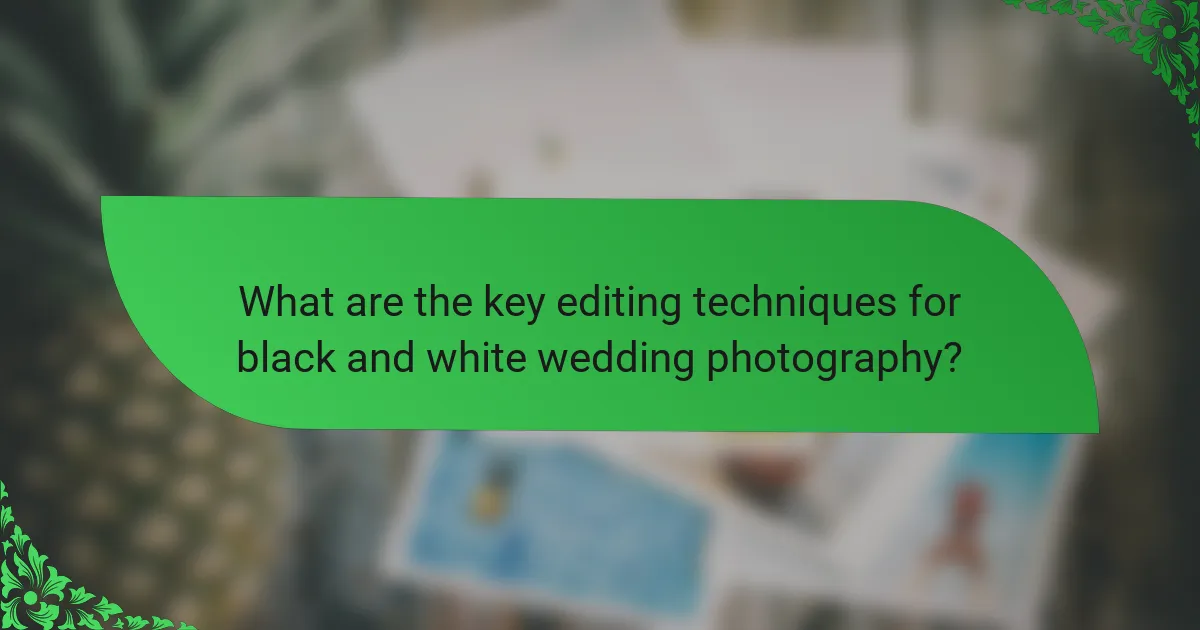
What are the key editing techniques for black and white wedding photography?
Key editing techniques for black and white wedding photography include contrast adjustment, tonal range manipulation, and sharpening. Contrast adjustment enhances the distinction between light and dark areas. This creates a more dynamic image. Tonal range manipulation allows photographers to emphasize highlights and shadows. This technique can add depth and drama to the photographs. Sharpening enhances details, making textures more pronounced. It is essential for capturing intricate elements of the wedding. Additionally, using filters can influence the mood. For example, a red filter can darken skies and enhance skin tones. These techniques collectively contribute to the overall aesthetic of black and white wedding photography.
How do photographers convert color images to black and white?
Photographers convert color images to black and white by removing color information. They often use software like Adobe Photoshop or Lightroom. The process involves desaturating the image, which eliminates hues while retaining luminance. Photographers may adjust contrast and brightness to enhance details. They can also use filters to emphasize specific tones. This technique allows for creative expression and mood setting. Many photographers utilize presets for consistent results. The final image often highlights textures and shapes more effectively.
What software tools are commonly used for black and white conversions?
Adobe Lightroom is a commonly used software tool for black and white conversions. It offers a range of presets and editing features specifically designed for monochrome photography. Another popular tool is Adobe Photoshop, which provides advanced control over tonal adjustments in black and white images. Capture One is also favored by professional photographers for its powerful editing capabilities and customizable color grading. Silver Efex Pro, part of the Nik Collection, specializes in black and white conversions with various film emulation options. These tools are widely recognized for their effectiveness in enhancing the aesthetic quality of black and white photography.
What are the best practices for adjusting contrast and brightness in black and white images?
To adjust contrast and brightness in black and white images effectively, utilize histogram analysis. A histogram displays the tonal range of an image. Ensure the histogram spans the entire width for optimal contrast. Increase brightness by adjusting the midtones without losing detail in highlights and shadows. Use adjustment layers for non-destructive editing. This allows for easy modifications and fine-tuning. Gradual adjustments prevent abrupt changes that can harm image quality. Regularly compare adjustments with the original image to maintain a balanced aesthetic. These practices enhance the visual impact and depth of black and white photography.
What role does exposure play in editing black and white wedding photos?
Exposure is crucial in editing black and white wedding photos. It determines the brightness and contrast of the image. Proper exposure ensures that details in highlights and shadows are visible. Underexposed images may lose detail in darker areas. Overexposed images can appear washed out, losing texture. Adjusting exposure during editing helps achieve a balanced tonal range. This enhances the overall aesthetic of the photograph. A well-exposed black and white photo can evoke emotions effectively. Therefore, exposure plays a significant role in the final presentation of wedding memories.
How can exposure adjustments enhance the mood of black and white images?
Exposure adjustments can significantly enhance the mood of black and white images. By increasing exposure, images can appear brighter and more uplifting. This can evoke feelings of joy and optimism. Conversely, decreasing exposure can create darker tones. Darker images often convey a sense of drama or melancholy.
The contrast between shadows and highlights is crucial in black and white photography. Proper exposure can emphasize textures and details. This adds depth and interest to the image. According to a study by Ansel Adams, exposure directly influences the emotional response to photographs. Adjusting exposure allows photographers to manipulate the viewer’s perception and emotional reaction.
What techniques can be used to correct exposure issues in black and white photography?
Adjusting exposure in black and white photography can be achieved through various techniques. The first technique is using exposure compensation during the shooting process. This allows photographers to adjust the camera settings to prevent underexposure or overexposure.
Another technique involves utilizing the histogram. Analyzing the histogram helps in identifying exposure issues, ensuring that highlights and shadows are well-represented.
Post-processing is also crucial for correcting exposure. Software like Adobe Lightroom or Photoshop can adjust brightness and contrast effectively.
Dodging and burning techniques allow for selective exposure adjustments. Dodging lightens specific areas while burning darkens them, providing more control over the final image.
Additionally, using filters during shooting can enhance contrast and manage exposure. A red or yellow filter can help in emphasizing certain tones in black and white images.
These techniques collectively improve the overall exposure quality in black and white photography.
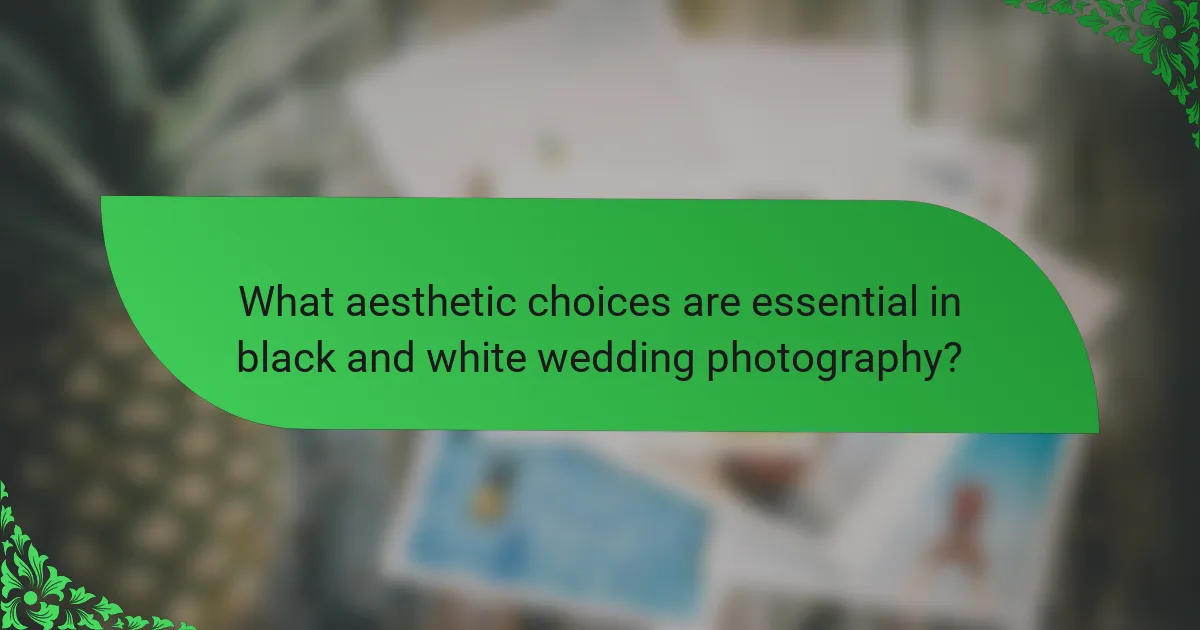
What aesthetic choices are essential in black and white wedding photography?
Essential aesthetic choices in black and white wedding photography include contrast, composition, and lighting. High contrast enhances the emotional impact of images. It emphasizes shadows and highlights, creating depth. Composition plays a crucial role in guiding the viewer’s eye. Strong lines and framing can elevate the visual narrative. Lighting is vital; soft diffused light often works best for romantic scenes. Harsh light can create dramatic effects, suitable for bold moments. Texture becomes more pronounced in black and white, adding interest. Ultimately, these choices shape the storytelling aspect of wedding photography.
How do composition and framing differ in black and white photography?
Composition in black and white photography focuses on the arrangement of elements within the frame. It emphasizes shapes, lines, and textures since color is absent. Framing, on the other hand, involves how subjects are positioned within the boundaries of the photograph. It dictates the viewer’s focus and perspective.
In black and white photography, strong contrasts become crucial for effective composition. The absence of color enhances the importance of light and shadow. This contrast can lead to more dramatic and impactful images. Framing can utilize natural elements or architectural lines to guide the viewer’s eye.
Both composition and framing work together to create a cohesive image. Effective composition can enhance the framing, while thoughtful framing can elevate the overall composition. Each plays a distinct role in conveying emotion and narrative in black and white photography.
What are the best practices for composing striking black and white wedding shots?
To compose striking black and white wedding shots, focus on contrast and texture. High contrast enhances emotional impact in images. Use natural light to create dramatic shadows and highlights. Framing is essential; include interesting backgrounds to add depth. Capture candid moments for genuine emotion. Use leading lines to draw attention to the couple. Pay attention to composition rules, such as the rule of thirds. Experiment with angles to find unique perspectives. These practices result in visually compelling images that resonate with viewers.
How can negative space be effectively utilized in black and white photography?
Negative space can be effectively utilized in black and white photography by creating balance and emphasizing the subject. It allows the viewer’s eye to focus on the main subject without distractions. The contrast between the subject and the surrounding empty space enhances visual interest. Using negative space can evoke emotions and convey a sense of isolation or simplicity. Photographers can frame their subjects against vast, uncluttered backgrounds to achieve this effect. Techniques such as leading lines and strategic cropping can also enhance negative space. Additionally, the absence of color in black and white photography amplifies the impact of negative space. This approach has been widely used by renowned photographers like Ansel Adams, who mastered the use of space to create powerful imagery.
What lighting considerations are important for black and white wedding photography?
Lighting is crucial for black and white wedding photography. It influences contrast, texture, and mood in images. Soft, diffused lighting creates gentle shadows and smooth tones. Harsh lighting can produce strong contrasts and dramatic effects. Direction of light affects how subjects are illuminated. Side lighting enhances texture and depth, while front lighting flattens features. Backlighting can create silhouettes, adding emotional impact. Natural light is often preferred for its softness and variation. Artificial lighting should be carefully controlled to avoid unwanted color casts. Proper exposure is essential to capture details in both highlights and shadows.
How does natural light affect the quality of black and white images?
Natural light significantly enhances the quality of black and white images. It creates depth and dimension through shadows and highlights. The direction of natural light influences contrast, making textures more pronounced. Soft, diffused light reduces harsh shadows, resulting in a more even tonal range. Conversely, direct sunlight can create strong contrasts, emphasizing details in the image. The quality of natural light can evoke different moods, impacting the overall aesthetic. For instance, golden hour light offers warm tones that can enrich the grayscale. Photographers often prefer natural light for its ability to create dynamic compositions in black and white photography.
What tips can enhance the use of artificial lighting in black and white photography?
Use soft, diffused lighting to enhance texture in black and white photography. Soft light minimizes harsh shadows and creates a more even tonal range. Experiment with different light sources, such as LED panels or softboxes, to achieve the desired effect. Position the light at various angles to highlight details and depth in the subject. Incorporate backlighting to create silhouettes and dramatic contrasts. Use reflectors to bounce light and fill in shadows, adding dimension. Adjust the color temperature of artificial lights for warmer or cooler tones, influencing the overall mood. Finally, practice with manual settings on your camera to control exposure and achieve optimal results.
What are some practical tips for achieving stunning black and white wedding photography?
To achieve stunning black and white wedding photography, focus on contrast and composition. High contrast enhances the emotional impact of images. Use natural light to create depth and shadows. Pay attention to textures, as they stand out in monochrome. Capture candid moments to convey genuine emotions. Frame subjects using leading lines to guide the viewer’s eye. Experiment with angles for unique perspectives. Utilize post-processing software to adjust tones and enhance details. These techniques can significantly elevate the quality of black and white wedding photos.
The main entity of the article is black and white wedding photography, which emphasizes capturing emotions and moments through contrast, texture, and composition without the distraction of color. The article provides an overview of the aesthetic benefits, emotional impact, and key editing techniques associated with this photography style. It discusses how black and white imagery differs from color photography, highlighting its ability to evoke nostalgia and timelessness. Additionally, the article outlines best practices for composition, lighting, and exposure adjustments that enhance the overall quality of black and white wedding photos.
